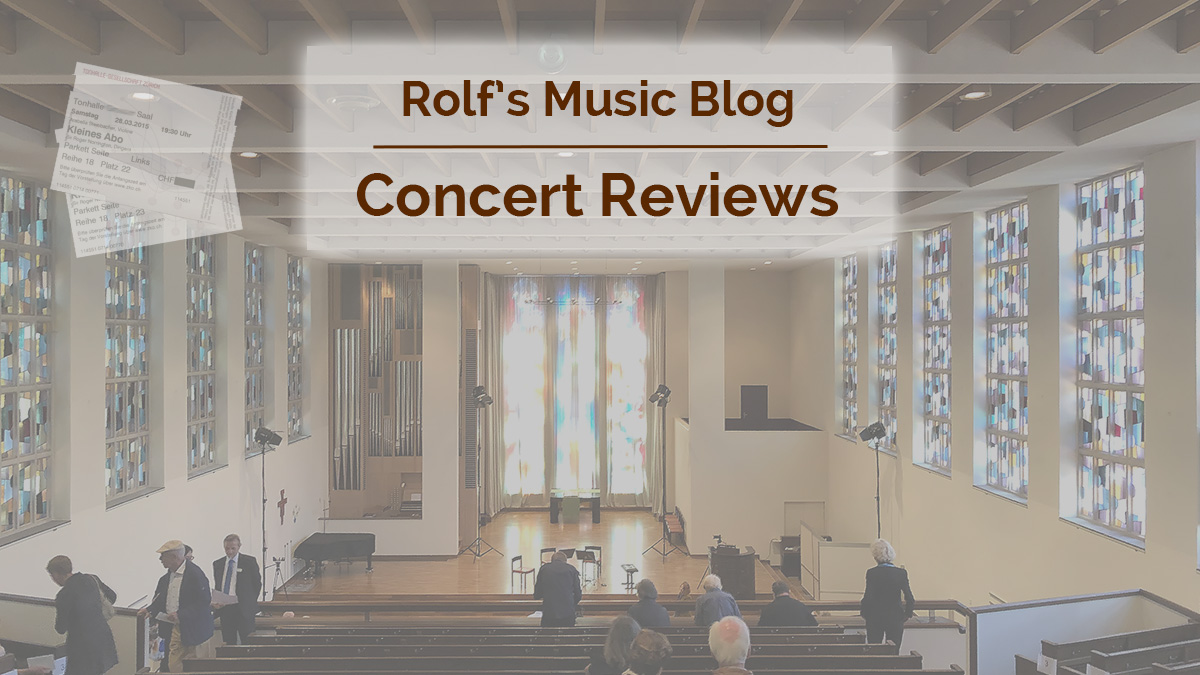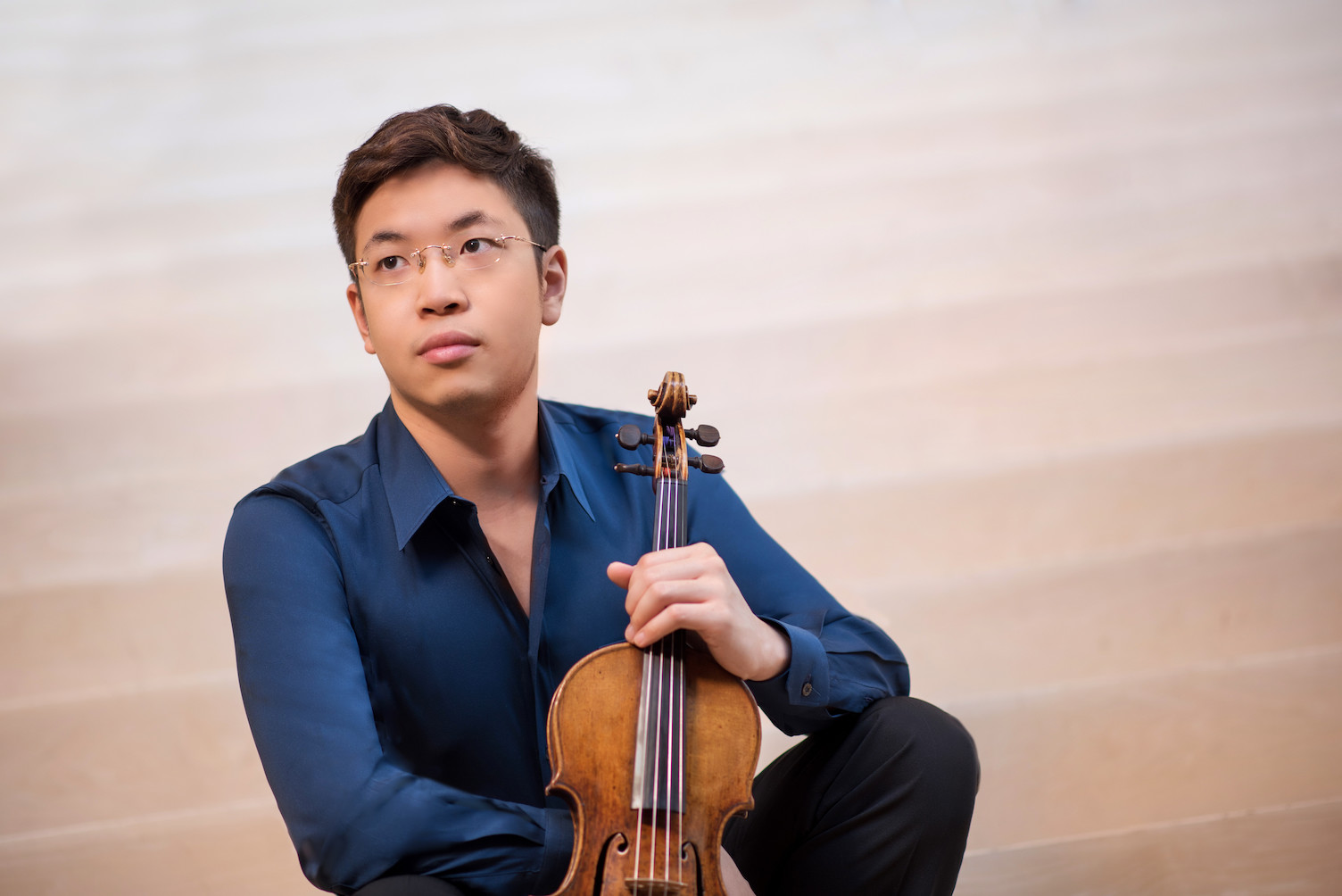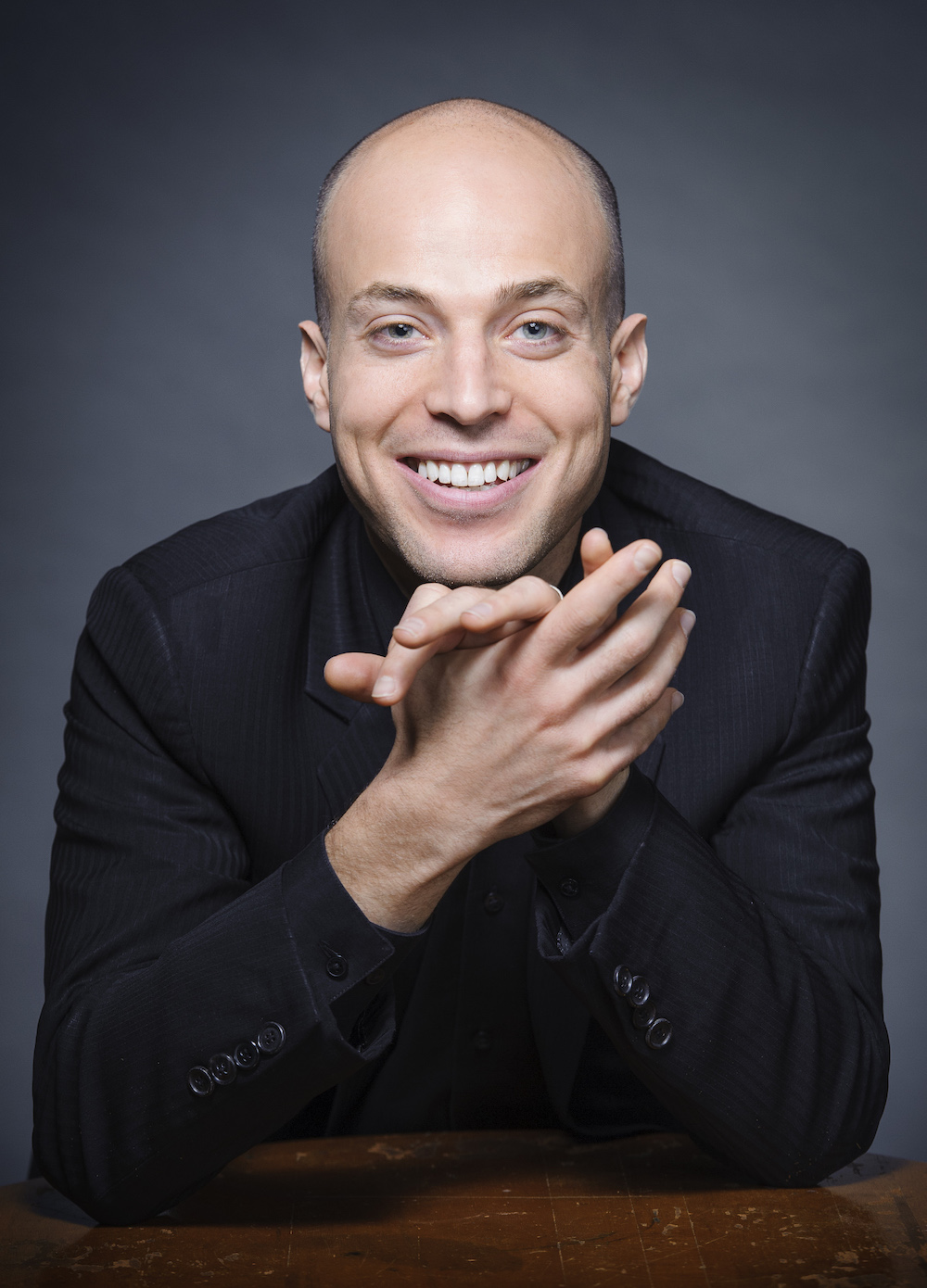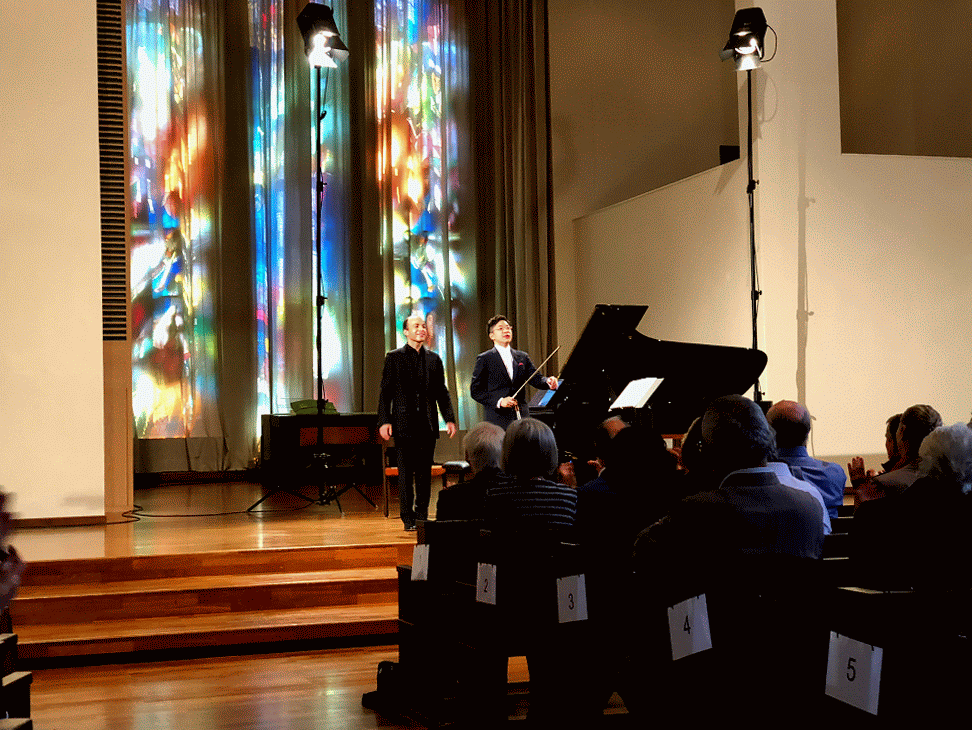Paul Huang & Orion Weiss
Dvořák / Prokofiev / Ysaÿe / Franck
Lukaskirche, Lucerne, 2018-09-04

2018-09-11 — Original posting
Table of Contents
Introduction
One component of the Lucerne Festival is its “Debut Series”, where young artists get a chance to give a lunchtime solo or duo recital in the Lukaskirche. The 2018 summer festival includes seven such debut recitals. This review is about No.4, with the Taiwanese violinist Paul Huang (*1990). Hwang started playing the violin at age 7. Around 2004, he moved to New York, to study at Juilliard School. His principal teachers were Hyo Kang and I-Hao Lee. In 2009, he won the Tibor Varga Competition in Sion, further prizes, grants and awards followed 2011 – 2017. He has since started a career as soloist and chambers musician. Paul Huang plays on the 1742 “ex Wieniawski” violin by Giuseppe Guarneri del Gesù (1698 – 1744).
Paul Huang’s duo partner in this concert was the American pianist Orion Weiss (*1981, see also Wikipedia), who took his education from the Cleveland Institute of Music, then changing to the Juilliard School. Weiss had his concert debut 1999 in Cleveland and is since pursuing a career as concert pianist. A particular focus in Orion Weiss‘ activities is in the area of chamber music. He is covering a broad repertoire, from Domenico Scarlatti to contemporary composers. He is also performing as duo partner with his wife, pianist Anna Polonsky. In this recital, Orion Weiss was playing a Steinway D-274 concert grand (the lid fully open).
The Program
The program featured four works for violin and piano (or piano and violin):
- Antonín Dvořák: Sonatina in G major, op.100, B.183
- Sergei Prokofiev: Violin Sonata No.1 in F minor, op.80
- Eugène Ysaÿe: Rêve d’enfant in A♭ major, op.14
- César Franck: Sonata in A major, FWV 8
- Encore
This mid-day concert in the Lukaskirche (on a Tuesday with beautiful early autumn weather) was not sold out. I estimate that about 70% of the seats were occupied. I had a left side stall seat in row 9, with good view onto the violinist. The latter partly / mostly covered the pianist: Huang was typically facing the audience, with Orion Weiss in his back.
Dvořák: Sonatina in G major, op.100, B.183
The Sonatina in G major for violin and piano, op.100, B.183, by Antonín Dvořák (1841 – 1904), fits perfectly into the main theme for this year‘s Lucerne Festival: “Childhood”. Indeed, Dvořák composed this in 1893, in New York, for his two eldest children (then 10 and 15), in memory of his own musical childhood. It‘s a sonata with modest technical demands, but nevertheless beautiful music. Upon listening, it strongly reminds me of Sonatinas for violin and piano by Franz Schubert (1797 – 1828). It comes in four movements:
- Allegro risoluto
- Larghetto — Poco più mosso
- Scherzo: Molto vivace — Trio
- Finale: Allegro — Molto tranquillo — Allegro
I have added some descriptive remarks in the sections below.
The Performance
I. Allegro risoluto
As for the sound of the violin, I noted mellow articulation, a well-rounded tone, with an occasional, slight tendency towards belly notes, certainly not overly percussive. However, in f passages, Huang often switched to a more grippy tone (more of course in the subsequent sonata by Prokofiev!). I would describe his playing as portato-dominated, not extreme legato. He showed a smooth tone with a natural vibrato—everywhere. Unfortunately, the acoustics seemed non-ideal for the violin, in that the reverberation was blurring Huang‘s articulation.
Orion Weiss proved an excellent accompanist: discreet, attentive, never oppressive in tone and volume. To the contrary: in the Sonatina, and this movement in particular, Weiss kept a low-key background role. A word about the music: so serene (particularly the ending!), such a happy, joyful mood, with only a very slight, “Czech” melancholic undertone. — ★★★
II. Larghetto — Poco più mosso
Here now, Huang‘s articulation was even softer, if not somewhat “cloudy”, with frequent use of portamento (and enough vibrato!). The violinist created a “covered” sound, almost as if he was using a mute. In the Poco più mosso segment, the violin is the accompaniment, and it was Orion Weiss‘ turn to switch to mellow, soft articulation, a “covered” tone. — ★★★
III. Scherzo: Molto vivace — Trio
The Scherzo followed attacca, all repeats were performed (AABB-CCDD-AB): another serene movement, light, joyful, lucid, happy, singing! The articulation on the violin was lighter, with more focus on precision. Orion Weiss‘ piano accompaniment was equally light and joyful.
With the Trio, the tone turned slightly more elegiac, somewhat melancholic, with a melody (and harmonies) that reminded of Scottish or Irish folk music. It remained vivid, though, with determination, especially in the more dramatic middle part. — ★★★½
IV. Finale: Allegro — Molto tranquillo — Allegro
The Allegro was as lively as the Scherzo. Already the first part includes Czech melodic elements. The Molto tranquillo, however, features a beautiful, melancholic, Bohemian tune: marvelous music! A premonition of the slow movement in the Symphony No.9 in E minor, op.95, “From the New World”? In the second instance, though, that folk tune turns more earnest.
Paul Huang‘s intonation was very good in general. The whole sonata performance demonstrated excellent duo playing. One restriction: much of the clarity was lost due to the acoustics (maybe it would have been better if the venue was sold out?). Under the given circumstances, to lighten up the articulation, maybe it would have been advantageous to use less sustain pedal on the piano? — ★★★½
Overall Rating: ★★★
Prokofiev: Violin Sonata No.1 in F minor, op.80
Sergei Prokofiev (1891 – 1953) composed two violin sonatas. The first one, the Violin Sonata No.1 in F minor, op.80, was actually completed 1946 (started 1938), two years after the Sonata No.2 in D major, op.94a. The article on Wikipedia describes the sonata op.80 as one of the composer’s darkest works. It features four movements:
- Andante assai
- Allegro brusco
- Andante
- Allegrissimo — Andante assai, come prima
In an earlier note, I have posted a comparison of two recordings of this sonata.
The Performance
I. Andante assai
Already the first tones, in which Orion Weiss aptly created this “hollow”, mystery-laden sound, the audience found itself in a radically different atmosphere. The violin followed suit, now with new tone qualities: grippy, rough, almost “sandy”. While the piano tuning in the bass register seemed slightly sub-optimal, Paul Huang’s intonation was very good, the articulation broad, but clear. In the accompaniment, the piano lines (which Orion Weiss kept calm, quiet) continued to form a dark, somber back- and underground.
Paul Huang created impressive, expansive dynamics. Rhapsodic preluding on the violin, which towards the end turns into wide-spanning, free-flowing arpeggiando, intermittent flautando, alternating with very expressive, at times even resolute pizzicato. Nothing in this was show or extroverted virtuosity. — ★★★★
II. Allegro brusco
The resolute pizzicato in the first movement appeared like a premonition of things to come: the tone here was (is meant to be) really resolute, if not angry! In all this, Paul Huang’s Guarneri violin projected well, had no problems “withstanding” the sound of the piano, was lighting up in the sudden, beautiful cantilena. That of course was merely an episode: the brutalist passages of the Allegro brusco returned, driven by the violin part, maintaining excellent coordination between the two instruments.
Paul Huang seemed to master the technical challenges in this movement without the slightest technical problems. The same could be said about Orion Weiss’ piano playing. The coordination between the two was excellent. Even in the wildest dissonant quarrels, the music seemed to depict a sophisticated interaction between the two musicians, occasionally cosy, but mostly very dramatic. Nothing could be farther from boring than this. Interestingly, there seemed to be a distinct beauty in all the dissonances!
I found that compared to the Dvořák Sonatina, the performance of the Prokofiev sonata was far less affected by the reverberating acoustics. — ★★★★
III. Andante
Also here, Paul Huang seemed to be “in the driver seat”, Orion Weiss kept a secondary role as accompanist, providing the harmonic background for the violin’s intense cantilena. I’m not sure that this much intensity is needed. I personally see this movement more as poetic than intense. Here, gradually, the scenery seemed to transcend into one of loneliness—a deserted landscape? A very atmospheric performance. — ★★★½
IV. Allegrissimo — Andante assai, come prima
An enthralling movement, presented in a forward-leaning tempo! The artists went to the technical limits, their playing was highly virtuosic. However, I found that for this tempo (in the initial segment), there was too much reverberation in this venue. — ★★★★
Needless to say: the sonata is a true musical masterpiece—strenuous, though, more than playful, for sure. Both artists proved excellent technical skills, high virtuosity. Paul Huang never seemed to have any technical issues, and it fascinated to see how he was able to create and play with sound colors on his instrument.
Overall Rating: ★★★★
Ysaÿe: Rêve d’enfant in A♭ major, op.14
The Belgian Eugène Ysaÿe (1858 – 1931) was a famous violin virtuoso, conductor, and composer. His Rêve d’enfant (Children’s Dream) in A♭ major, op.14, from 1894, is one of several compositions that he wrote, for violin and small orchestra. In the case of op.14, Ysaÿe also included a version for violin and piano.
The Performance
An introverted, pensive piece and interpretation, full of warm feelings. The artists played with nice, swaying agogics, and Orion Weiss kept the emotional excursions at bay. However, I personally found that Paul Huang used too much vibrato, plenty of portamento—too romantic, in my opinion. For a piece depicting a child’s dream (or trying to make a child dream, maybe even to be a child’s dream?), I think the playing should be less pretentious, simpler, unadorned. Also, the strong vibrato did not match well with the occasional straight note on an empty string.
Rating: ★★★
Franck: Sonata in A major, FWV 8
In an earlier post from 2012-07-30, I have briefly touched upon a few recordings of the Sonata in A major, FWV 8, which César Franck (1822 – 1890) composed 1886. That work is mostly known as Sonata for violin and piano, though the composer also created a version for cello and piano. As indicated in my earlier post, there are at least voices claiming that the original version is the one for cello. The sonata—one of the most beautiful chamber music compositions of the 19th century—features four movements:
- Allegretto ben moderato
- Allegro
- Ben moderato: Recitativo-Fantasia
- Allegretto poco mosso
I have written about a concert performance of this sonata in the review of a recital on 2017-11-21.
The Performance
I. Allegretto ben moderato
The tempo annotation is merely descriptive, leaving it up to the artist to decide “how much moderated” the ben moderato means, and to what degree to retain the “a little joyful” of the Allegretto. Personally, I found the tempo a tad fast. I often felt a slight unrest, which limited the serenity of this music. At the same time, Paul Huang’s vibrato was a tad strong, the portamenti a bit too frequent, prominent. Also, Orion Weiss seemed to use a fair amount of sustain pedal. A very romantic interpretation, overall—in today’s terms, at least. My preference would be a less pretentious interpretation (with less vibrato, obviously). — ★★★
II. Allegro
A very virtuosic piece in the piano, with emotions almost boiling over! The tempo was very fluent here, probably at the limit with the amount of reverberation: some details in the articulation appeared blurred. And also here, Paul Huang chose a very romantic approach. In my opinion, this didn’t help the music, as that is romantic enough already. But of course, everybody enjoyed the generous sound of the Guarneri violin! Apart from the slight excess in romanticism, the vivid parts of the performance were impressive, played with heart, with strong emotions. Not unexpectedly, the tempo once more reached the limits in the quasi presto Coda. The performance obviously impressed—spontaneous applause was about to break out! — ★★★
III. Ben moderato: Recitativo-Fantasia
The Recitativo in the violin was really excellent: “talking”, expressive, expansive, one could almost associate words, phrases with the singing of the Guarneri! Orion Weiss supported this with suitable agogics and rubato in the accompaniment.
There are also rhapsodic periods—here, I found the emotions in the violin part a bit overdone. Similarly, I would have preferred the elegiac sections (mostly pp) to be simpler, less (over)loaded with vibrato and emotions. — ★★★½
IV. Allegretto poco mosso
These nice cantilenas—flourishing in Paul Huang’s hands: gradually it grew out of the restrained beginning, gained intensity, seemed to glow. Besides (still!) a slight excess in vibrato, my main quibble here is with the slight unrest, the occasional pushing: this music could be more calm, more contemplative, also considering the acoustics in this venue. But I concede that the artists are often playing “on a knife’s edge” in trying to maintain flow and tension: the gap between pushing the tempo and losing the tension is often very small. — ★★★
Overall Rating: ★★★
Encore — Schumann: Träumerei
It was an excellent debut performance that deserved the strong, lasting applause. As encore, the artists wisely selected a calm, reflective piece: from the Kinderszenen (Scenes from Childhood), op.15, by Robert Schumann (1810 – 1856), the No.7, “Träumerei“ (Dreaming), in an arrangement for violin and piano. I don’t want to judge this to severely—it’s merely an encore, after all. Still, here, the vibrato and the number of portamenti was definitely excessive, the music overly sweet: this is meant to be music to be played for children, after all!






